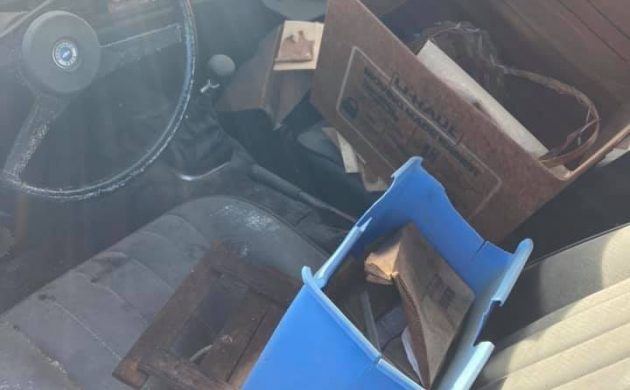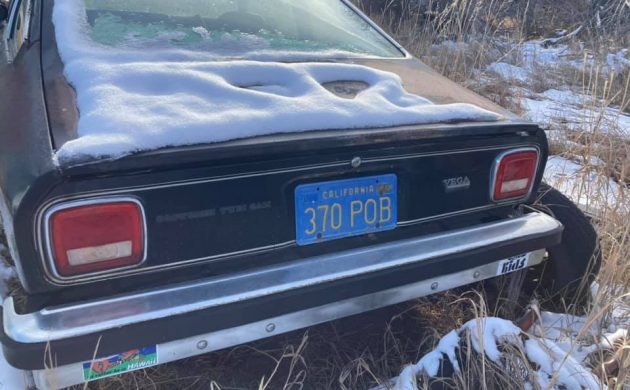The march of time can either be cruel or kind, so take a look at this 1975 Chevrolet Vega Cosworth and see if you can decide which is the case here. The Vega has been sitting behind a barn exposed to the elements for a while, and this first photo is not encouraging. However, there could be more here than meets the eye. I have to say a big thank you to Barn Finder JagManBill for spotting the Vega for us. It is located in Fort Collins, Colorado, and has been listed for sale here on Facebook. The owner hasn’t set a price but is willing to listen to offers.
Even when it was new, the Vega was not a car renowned for its ability to resist rust. Time hasn’t improved the situation, and when you find one that has been sitting exposed to snow and surrounded by long grass, the alarm bells have to start ringing loud. The photos aren’t the greatest, but while the car wears plenty of surface corrosion, surprisingly little penetrating rust is visible. There could be some small areas in the lower rear quarter panels, but even that is not definite. Of course, we can’t see the state of the floors, and the story there could be completely different. There is some evidence that there could be rust under the battery tray, which is a common problem. My greatest concern here is the fit of the driver’s door. It is inconsistent and could indicate that the car is beginning to sag due to structural issues. If that is the case, then the Vega will only be good for parts. Even if it does turn out to be a parts car, there are plenty of pieces that a buyer could salvage for another project.
The Vega is mechanically complete, so if its destiny is as a parts car, there is an entire drivetrain here that can potentially be refurbished and reused. The air injection system has been removed, but that seems to be the only missing item. The Vega Cosworth has always been a car that makes me scratch my head. The engine is something quite special, and a large part of its development fell to a company with considerable motorsport success. The ingredients were all there to create a barnstorming classic. The 122ci 4-cylinder engine features full alloy construction, with a twin-cam cylinder head developed by the legendary Cosworth Engineering. Throw fuel injection and stainless steel exhaust headers into the mix, and big horsepower numbers should have been the result. That the production version pumped out a mere 110hp was slightly disappointing. However, when the next most potent engine in the Vega range was the 140ci 4-cylinder that delivered 87hp, things suddenly didn’t look that bad with the Cosworth. The amount of money and resources that Chevrolet threw at the project is staggering. Each engine was hand-assembled in a “clean” room in a bid to maintain mechanical integrity and maximize performance potential. Eventually, 5,000 of these engines were made, but only 3,508 cars were built during 1975 and 1976. Of the remaining 1,492 engines, 500 were dismantled for parts, while Chevrolet scrapped the rest. It isn’t clear what condition this one is in, but it might be a candidate for a rebuild if it turns freely. Chevrolet reportedly extracted more than 170hp from pre-production engines, so it would be interesting to see what sort of power could be produced on a rebuilt engine with a bit of tweaking and tuning.
Even though there’s a lot of junk piled inside the Vega, it does appear that the interior is complete. Two of the most critical components here are the gold machine-turned gauge fascia and the numbered dash plaque. Both are still present, which is a bonus. If the car is to be tackled as a restoration project, then a complete interior refurbishment will be on the cards. It looks like most of the upholstery is toast, as is the carpet and dash pad. Once again, if we are looking at this purely as a parts car, then there is a veritable treasure trove of parts to be had here.
There’s no hiding the fact that returning this 1975 Vega Cosworth to its former glory will take some work. Whether it is a viable proposition could only be determined by subjecting the car to a thorough inspection. In the 1975 model year, only 2,061 examples of the Vega Cosworth were built, making them a rarity when they were new. One of the problems with the car was the price. It retailed at a touch under $6,000 back then, and that price put it perilously close to an entry-level Corvette. In the public’s eye, one of those cars had distinctly more “street cred” than the other as a performance vehicle, and it wasn’t the Vega. It is still possible to find a driveable Vega project car today for under $6,000. However, something strange has happened to the value of these little classics. The second half of 2020 has been extraordinarily kind to them, and values have increased dramatically. The result is that in January 2020, a good original example could cost around $15,000. Today, that same car will command a figure of about $20,000. That isn’t the end of the story because there have been some pristine examples in the last couple of months that have topped $35,000. Maybe the Vega Cosworth’s time has finally arrived, which means that it could be worth giving this one a closer look.







In all honesty, IF I had to have a Vega, the Cosworth would be the last one I’d look at. Like all “collectible cars” , a lot were stored away and there seems to be plenty around compared to a run of the mill Vega , so trying to restore one of these doesn’t make sense to me. . I like to have something different ; finding a rust free pre 74 Vega would be the direction I was heading .
This will be parts for some one else’s restoration. As Don said, there was too many built and too many in far better shape to be had for reasonable money to even think of restoring this.
You’d be underwater in a heartbeat with it.
It’d be fun though to yank that drivetrain and put it in to a wagon chassis though. Make the only Cossie Wagon perhaps?
3500 is TOO many ?Do you even know how many Cosworths have been put down due to rust thru and battery corrosion really being the limiting factors in a restoration,I’ve scrapped five myself.While still having three,one rusted,1 restored ,one bought as a v8 conversion,so 8 numbers accounted for by me,here in Maine ! Whereas most sixties collectables number in 10’s of thousands,so think things thru before you profer an opinion on collectability ?
“The owner hasn’t set a price but is willing to listen to offers.”
Don’t waste your time.
I was thinking crazy thought like putting that engine in a Spitfire….
Now thats a good idea
I think there was a typo in the license plate. It reads 370 POB. It was supposed to read POS.
Parts car to keep your other Cosworth on the road.
My bother had one in the mid 80’s and his driver’s door sagged like this one too. Always had to slam it shut. Could never get the engine to idle right either. It was noisy and slow. The 72 Maverick I was driving at the time felt like a better built car.
Pull the rubber band engine and v8 .
Funny they complain about Vegas resting away in the showroom, when mopars did the same thing !
Well, at least they didn’t rust away!
Good write up. Interesting the Cosworth engine was designed around a Ford engine. Back yard neighbor had a Vega in the ’70s that came with rust from the dealer. Nice design but poor construction for sure.
learned to drive a stick .in my brothers vega.fond memories.
4,150 miles? This may have been one of the many speculator/collector bought Cosworths that spent decades waiting to appreciate. I guess at some point they figured storing it properly was just throwing good money after bad.
Just a warning, these cars were made of compressed rust, and I believe that engine block was the same nik-o-sil aluminum used in the run of the mill Vega horrors However if you can look beyond these problems,they could have been a cool car.
I had a 76, took off the bendix injection that really was Bosch,used Porsche 911 injectors. Put on twin Weber 45DCOE, added double roller timing chains. Cut off catalytic, damn she was FAST!! And kinda fun, never did rust. Kept it clean. Sold it when I need cash. 🤑🤑🤑I should have kept this one.